Climate Change and Mating
Air Date: Week of March 3, 2023
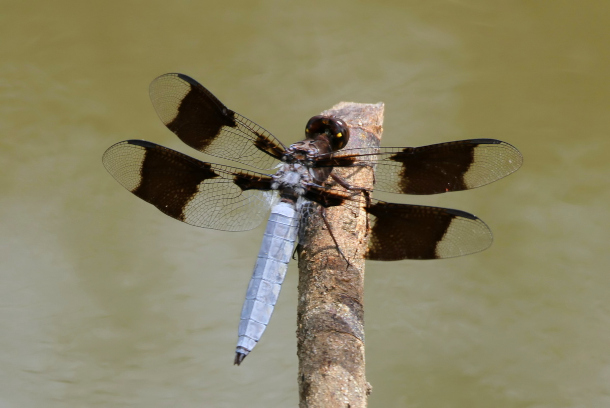
A common whitetail dragonfly. Evolutionary ecologist Michael Moore began investigating the link between climate change and mating when he learned dragonfly species that typically have dark wing pigmentation have less or no pigmentation in hotter parts of their species range. (Photo: TexasEagle, Flickr, CC BY-NC 2.0)
Showy traits like dark pigmentation on a dragonfly’s wings or a lion’s big, dark mane play a key role in how some animals choose a mate. New research suggests that climate change is making some classically attractive traits more difficult to pull off. Evolutionary ecologist Michael Moore at the University of Colorado Denver joins Host Bobby Bascomb to share more.
Transcript
BASCOMB: Most animals select a mate based on a phenotype, or observable trait. Think of a bird’s brightly colored feathers or a male lion’s mane. Certain traits are associated with better genes, so individuals will select a mate based on the quality of their display, which drives evolution of the species. But, climate change is making some classically attractive traits more difficult to pull off. For more I’m joined by Michael Moore, an assistant professor of Biology at the University of Colorado Denver. Michael Moore, welcome to Living on Earth.
MOORE: Thanks for having me.
BASCOMB: So this may be a bit of an obvious question, but can you give us a brief overview, please, of what is sexual selection exactly?
MOORE: Yeah, so sexual selection is a type of natural selection. But instead of the differences in individuals being the result of survival, it's differences in individuals being the result of reproduction. And so we often think about sexual selection as kind of the advantages that some individuals get from having these really big, showy traits. But really, it's about kind of any sort of traits that just sort of improves an individual's ability to coordinate mating and successfully mate with a partner.
BASCOMB: So is it about mating or successful offspring?
MOORE: It's often really hard to distinguish between those things. Usually, for practical reasons, we usually focus on the point at which two individuals mate with one another, but obviously, that mating doesn't do any good if they don't successfully have the offspring.
BASCOMB: And so what first got you interested in this question of how climate change is affecting sexual selection?
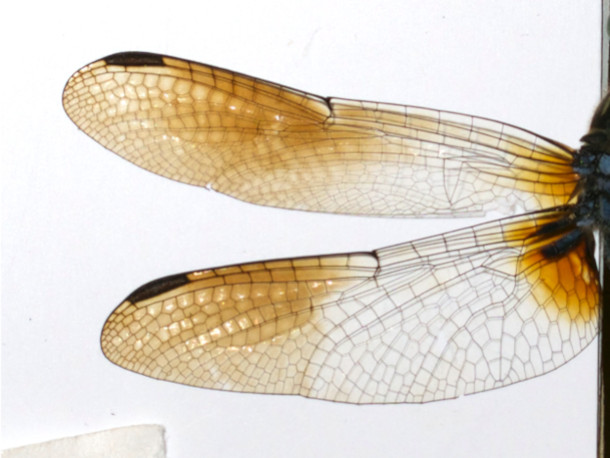
Example of dragonfly wing pigmentation. Although darker wings might attract more mates, they can cause the males who have them to overheat. (Photo: Courtesy of Michael Moore)
MOORE: Well, it started actually, with an observation that this dragonfly that I was working on for other research reasons, I was working on this trait that these dragonflies have that helps them in sexual selection. It's this dark pigmentation on their wings that males use to attract females and to scare off territorial rivals. And what was really interesting about this trait was that where I was working in Cleveland, the species that I was working on had this really big dark patch on its wing, but we knew in western portions of the species range, and in the southern portions of the species range, the dragonfly just didn't have any of this pigmentation whatsoever. And that was kind of an anecdote that I was aware of, but had kind of filed away for a rainy day. And then one sort of winter when I was unable to do the field research that I would normally do during my PhD because the dragonflies are all sleeping during that time, I started to think about what it might mean that these dragonflies don't seem to have this wind coloration in the hottest parts of the species range. And so what we found is that, you know, even though these dragonflies have this really important mating trait, because it's this dark pigmentation, it absorbs a bunch of solar radiation, and it leads to these dragonflies actually overheating in the warmest parts of the species range. And so we started by thinking about this question just in terms of long evolutionary histories, right, the kinds that were involved, as the species colonized all of North America. But then obviously, the immediate implication of that is, if dragonflies are having a hard time having this really important meeting trait in warm parts of the species range, will they also have a hard time having this really important mating trait as our climate continues to warm? And what my research indicates is that it appears that even just over the last fifteen years, we're starting to see really big shifts in how much wing pigmentation and how large these mating traits are for these dragonflies, as our climate continues to warm.
BASCOMB: I'm just wondering, in terms of these darker pigmented dragonflies, are you able to actually take their temperature or in some way learn that there may be overheating when they're darker and absorbing more of the solar radiation?
MOORE: Yeah, so we did an experiment where we captured dragonflies with different amounts of pigmentation on their wings, and we brought them into the lab and we heated them up under a lamp as if they were like out in the sun sort of collecting that solar radiation. What we found for this first study just by looking at individuals with natural differences in how big their pigmentation is, is that the individuals with more pigmented wings tend to heat up faster and to a higher overall temperature than the ones that have less of that pigmentation on their wings. The thing that was tricky about that, though, is that it's natural differences between individuals. And so it could be because of the wing coloration or it could be because of some other factor that's associated with the wing coloration. So what we did is we captured another set of dragonflies that all had very little wing pigmentation and then we manually added the pigmentation with a brown felt tip marker. And then as sort of a control in this experiment, we colored in the same region of the wing with colorless blending ink, which has all of the same sort of chemical properties as a felt tip marker, but lacks any of the dye. So that controls for any kind of effect of just putting the marker on the wing. And so we did the second experiment with these individuals where we augmented the wing coloration and individuals that had this control marker ink on the wing. And what we find is exactly the same pattern. So that gives us really strong experimental evidence that the wing coloration actually does seem to be associated with heating up.
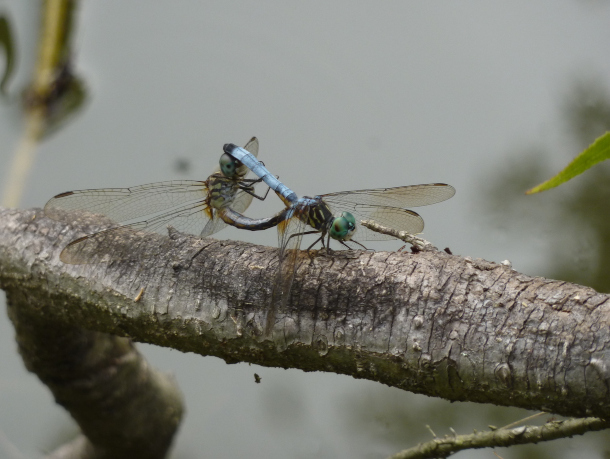
A pair of blue dashers mating. Researchers have yet to learn how changes in male wing coloration are affecting the way certain species mate. (Photo: reophax, Flickr, CC BY 2.0)
BASCOMB: So it is indeed the darker wings on the dragonfly that causes it to be warmer, not just some trait that dark winged dragonflies happen to have.
MOORE: Yeah, that's what it seems like.
BASCOMB: So if male dragonflies are becoming less dark as a way to stay cool, that must mean then that the less dark males survive better and were better able to reproduce, you know, more fit offspring.
MOORE: There's a few possibilities here. It could be that the females simply choose to mate with males that have less wing coloration, just like you said, and in that case, there wouldn't be necessarily any conflict over any of this. The females would choose the males that are going to have the wing coloration that they would like their offspring to have, because it'll be really well matched to the temperatures that their offspring are likely to face. The other possibility is that the females don't realize that they need to mate with males with less wing coloration, they either mate with males that have more wing coloration than is optimal for the climate, or, if they can't find those males, because all of those males have died or they're simply too warm to go to the breeding aggregations, then the females might not mate at all. And that's going to have really big implications for kind of the long term success of some of these populations. If females are essentially so choosy, and they can't find the mates that they have historically mated with because those males are dead, then we could see sort of really big declines in population because there's not successful reproduction occurring. So we don't know which of those possibilities is occurring yet. It's one of the things that my lab is starting to look at. But I don't have any clear answers for you at the moment.
BASCOMB: I know you've been looking at dragonflies, but what other animals out there are exhibiting changes in their mating behavior that you are attributing to climate change, potentially?
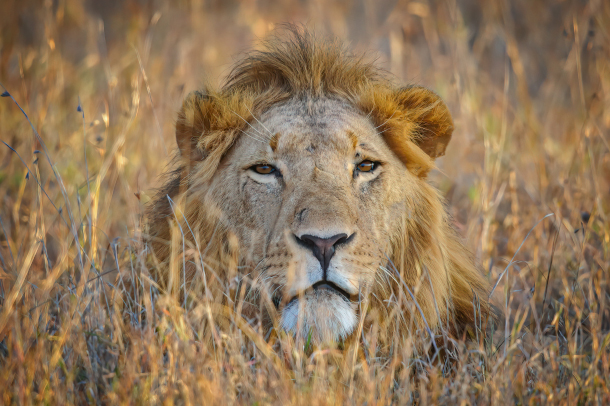
A lion rests in the grassland of Ol Pejeta Conservancy in Kenya. The big, dark manes that traditionally boost lions’ mating appeal may be hindering them more than helping them. (Photo: Diana Robinson, Flickr, CC BY-NC-ND 2.0)
MOORE: So we're still really in the early stages of a lot of it. But there's a lot of research going on. I think one of the real famous examples besides some of the dragonfly work that I've been doing is what we see in lions. And so lions that have really big dark manes also tend to overheat even though those big dark manes are beneficial to the male lions. So across these lions' geographic ranges in Africa, what we tend to find is that the lions in the hotter parts of Africa tend to have less dark manes or smaller manes. There's some interesting research in birds where some of their breeding plumage is starting to change as a result of it being too warm. Most of the research that we've looked at so far has really been about these kind of color based traits. But we're also starting to learn about other types of traits that might be affected that aren't necessarily as intuitive. So one of my collaborators at St. Louis University, Kasey Fowler–Finn, her research looks at how these little tree hoppers, which are these little insects, how they're able to sing under different climatic scenarios. And so what she's finding is that their songs are totally different at warm temperatures than they are at cool temperatures. And this has to do with their kind of energetics and some of the physics associated with how they sort of produce those vibrational songs that they use to communicate with one another.
BASCOMB: And those songs are used to attract a mate?
MOORE: Yep, in addition to attract mates, it's also to sort of tell another individual what species you are, and that has all kinds of implications for these things that we're talking about, about whether individuals of the same species can recognize one another, whether females can successfully choose the right male or not, all of these different things.
BASCOMB: Well, you know, climate change can mean a lot of things. It can be wetter or drier, you can have more storms, more extreme weather events, and of course, it's hotter. Are there other factors other than heat that are impacting the way that animals mate and choose their mates?
MOORE: Yeah, so one of my collaborators Noah Leith, who is also at St. Louis University, right now he's looking at how aridity is affecting some of these mating traits. And so he works on wolf spiders and so what's really interesting about spiders is that the way that they move their limbs is based on hydraulics. So they move fluid around in their body to sort of move their limbs and such. And so what he's looking at is, as the planet gets drier as a component of climate change, how are those drier conditions going to affect the mating behaviors of these spiders? And I think a lot of his research is still ongoing. We're not certain how the results are coming out. But we're definitely starting to think about some of the other impacts of climate change on some of these mating behaviors.
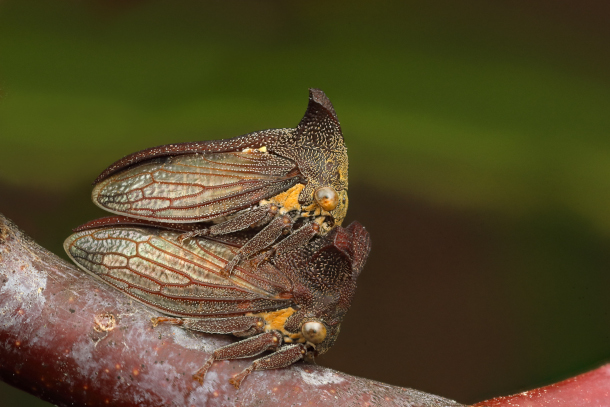
A pair of treehoppers. Researchers at the Fowler-Finn lab are looking into the ways warming temperatures are affecting treehoppers’ mating songs. (Photo: patrickkavanagh, Flickr, CC BY 2.0)
BASCOMB: Well, of course, you know, the Earth is not stagnant, and the climate has always been changing. But with anthropogenic climate change, it's the speed of change that's so concerning. How possible is it do you think for species to evolve enough to avoid this pattern that we've been talking about here, to be able to attract suitable mates when the game has changed for what suitable means anymore?
MOORE: So we know that in general, that many organisms do have the capacity to adapt to the rapidly rising global temperatures. But what we're seeing is that a lot of animals, even though they are showing some adaptation, it doesn't seem to be fast enough. And so a big question in biology right now is, is why aren't they adapting fast enough given that they, from what we understand about them, they do seem to have the resources to be able to facilitate kind of a genetic adaptation? And they do seem to show some response. It's just not big enough. So we don't know the answer to that yet. Increasingly, we're realizing that adaptation is one of the components that animals are going to have to use in order to respond to climate change. And so really getting to the bottom of this question I think is particularly urgent.
BASCOMB: Now from what I understand your study on dragonflies and their wing patterns use data generated by iNaturalist. Can you tell us a bit more about that and how people can get involved with this?
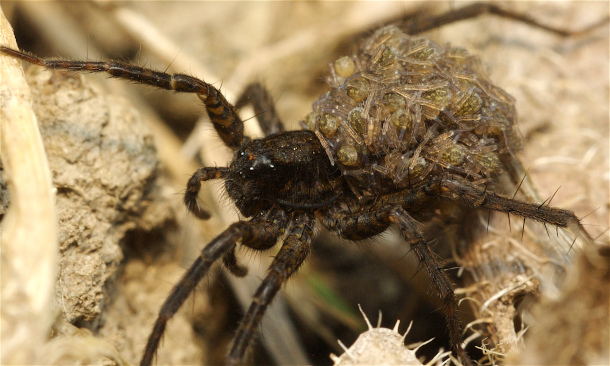
A wolf spider with spiderlings on her back. Noah Leith at St. Louis University is investigating how aridity affects wolf spider mating. (Photo: imarsman, Flickr, CC BY-NC-ND-2.0)
MOORE: So iNaturalist is this is really terrific, what we call citizen science platform. And so people can take observations of any kind of plant or animal or other organism they see just with their smartphone and upload it via this app to this website. But what is really exciting about the iNaturalist program to a researcher like me is that every time that someone takes one of those pictures and uploads it to the website, we have a record of an organism that was observed. We know when it was observed, we know where it was observed, and we have an image that we can use to study the traits of the animal. And so this has allowed us to do really cool things, to look at sort of geographic patterns and animal traits across North America. So that's actually how my dragonfly research was conducted. But we can also look at how animal traits are changing through time because we have that timestamp associated with each individual observation of the dragonflies. But there are other people who are really excited about getting citizen scientists involved and have specific projects on iNaturalist, and I encourage your listeners to go and check out some of those projects that are available and get involved as much as possible because the way that science is gonna have to move forward in the future is not just with or professional scientists like me, in the lab or in the field, but the scale at which we need to start to observe how organisms are responding to things like climate change is so large, that we're really going to need to involve every person to the extent that they're capable or interested.
BASCOMB: Michael Moore is an assistant professor of biology at the University of Colorado Denver. Michael, thank you so much for your time today.
MOORE: Thanks for having me.
Links
Washington Post | “Less Attractive, Less Picky: How Mating Is Changing in A Hotter World”
Science News | “Climate Change May Rob Male Dragonfly Wings of Their Dark Spots”
Click here to learn more about how climate change is affecting treehoppers’ songs
Living on Earth wants to hear from you!
Living on Earth
62 Calef Highway, Suite 212
Lee, NH 03861
Telephone: 617-287-4121
E-mail: comments@loe.org
Newsletter [Click here]
Donate to Living on Earth!
Living on Earth is an independent media program and relies entirely on contributions from listeners and institutions supporting public service. Please donate now to preserve an independent environmental voice.
NewsletterLiving on Earth offers a weekly delivery of the show's rundown to your mailbox. Sign up for our newsletter today!
 Sailors For The Sea: Be the change you want to sea.
Sailors For The Sea: Be the change you want to sea.
 The Grantham Foundation for the Protection of the Environment: Committed to protecting and improving the health of the global environment.
The Grantham Foundation for the Protection of the Environment: Committed to protecting and improving the health of the global environment.
 Contribute to Living on Earth and receive, as our gift to you, an archival print of one of Mark Seth Lender's extraordinary wildlife photographs. Follow the link to see Mark's current collection of photographs.
Contribute to Living on Earth and receive, as our gift to you, an archival print of one of Mark Seth Lender's extraordinary wildlife photographs. Follow the link to see Mark's current collection of photographs.
 Buy a signed copy of Mark Seth Lender's book Smeagull the Seagull & support Living on Earth
Buy a signed copy of Mark Seth Lender's book Smeagull the Seagull & support Living on Earth

